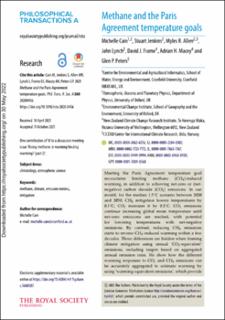| dc.contributor.author | Cain, Michelle | |
| dc.contributor.author | Jenkins, Stuart | |
| dc.contributor.author | Allen, Myles R. | |
| dc.contributor.author | Lynch, John | |
| dc.contributor.author | Frame, David J. | |
| dc.contributor.author | MacEy, Adrian H. | |
| dc.contributor.author | Peters, Glen Philip | |
| dc.date.accessioned | 2022-06-13T12:35:42Z | |
| dc.date.available | 2022-06-13T12:35:42Z | |
| dc.date.created | 2022-04-26T14:29:48Z | |
| dc.date.issued | 2022 | |
| dc.identifier.citation | Philosophical Transactions of the Royal Society A: Mathematical, Physical and Engineering Sciences. 2022, 380 (2215), . | en_US |
| dc.identifier.issn | 1364-503X | |
| dc.identifier.uri | https://hdl.handle.net/11250/2998544 | |
| dc.description.abstract | Meeting the Paris Agreement temperature goal necessitates limiting methane (CH4)-induced warming, in addition to achieving net-zero or (net-negative) carbon dioxide (CO2) emissions. In our model, for the median 1.5°C scenario between 2020 and 2050, CH4 mitigation lowers temperatures by 0.1°C; CO2 increases it by 0.2°C. CO2 emissions continue increasing global mean temperature until net-zero emissions are reached, with potential for lowering temperatures with net-negative emissions. By contrast, reducing CH4 emissions starts to reverse CH4-induced warming within a few decades. These differences are hidden when framing climate mitigation using annual ‘CO2-equivalent’ emissions, including targets based on aggregated annual emission rates. We show how the different warming responses to CO2 and CH4 emissions can be accurately aggregated to estimate warming by using ‘warming-equivalent emissions', which provide a transparent and convenient method to inform policies and measures for mitigation, or demonstrate progress towards a temperature goal. The method presented (GWP*) uses well-established climate science concepts to relate GWP100 to temperature, as a simple proxy for a climate model. The use of warming-equivalent emissions for nationally determined contributions and long-term strategies would enhance the transparency of stocktakes of progress towards a long-term temperature goal, compared to the use of standard equivalence methods. | en_US |
| dc.language.iso | eng | en_US |
| dc.publisher | The Royal Society publishing | en_US |
| dc.rights | Navngivelse 4.0 Internasjonal | * |
| dc.rights.uri | http://creativecommons.org/licenses/by/4.0/deed.no | * |
| dc.title | Methane and the Paris Agreement temperature goals | en_US |
| dc.title.alternative | Methane and the Paris Agreement temperature goals | en_US |
| dc.type | Journal article | en_US |
| dc.type | Peer reviewed | en_US |
| dc.description.version | publishedVersion | en_US |
| dc.source.pagenumber | 0 | en_US |
| dc.source.volume | 380 | en_US |
| dc.source.journal | Philosophical Transactions of the Royal Society A: Mathematical, Physical and Engineering Sciences | en_US |
| dc.source.issue | 2215 | en_US |
| dc.identifier.doi | 10.1098/rsta.2020.0456 | |
| dc.identifier.cristin | 2019239 | |
| dc.relation.project | EC/H2020/821205 | en_US |
| dc.relation.project | EC/H2020/820846 | en_US |
| dc.relation.project | EC/H2020/821003 | en_US |
| cristin.ispublished | true | |
| cristin.fulltext | original | |
| cristin.qualitycode | 2 | |

